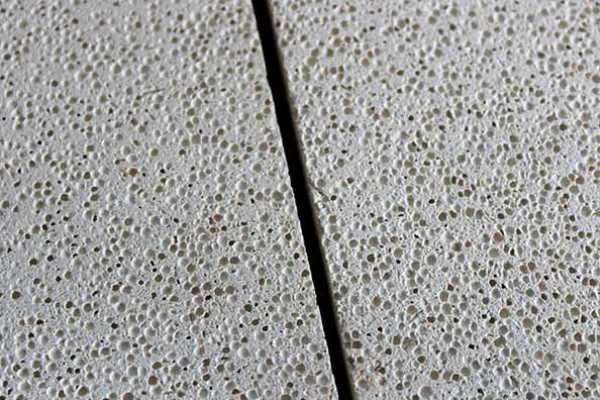
Corundum - mullite at the same time with corundum and mullite two excellent performances.
Porøs keramikk er et slags keramisk materiale som består av mange porer arrangert i rommet på forskjellige måter.
Porous ceramics according to the pore size can be divided into coarse aperture porous ceramics (pore diameter > 500μm) large aperture porous (500μm > pore diameter > 100μm), porous ceramics in the aperture (100μm > pore diameter > 10μm), porous ceramics in the small aperture (10μm > pore diameter > 1μm), porous ceramics (pore diameter < 1μm).
The structure of the pores in the ceramics can be divided into open pore type porous ceramics, closed pore ceramics, and penetrating porous ceramics. Porous ceramics have uniformly distributed pores or many penetrating pores, with high permeability. There are many pores in the matrix so it has a small bulk density.
Porous ceramics developed with specific surfaces can produce unique physical surface properties and can be formed on the liquid and gas media selective permeability, while further reducing the thermal conductivity of ceramics.
Samtidig, ceramic materials have unique high-temperature resistance, Korrosjonsmotstand, high chemical stability, and dimensional stability, porous ceramics as a new type of material developed rapidly.
For tiden, porous ceramics are used in gas sensors, catalyst carriers, filters for hot gases or molten metals, and high-temperature refractory insulation materials. As catalyst carriers, porous ceramics have the advantages of high-temperature resistance, Korrosjonsmotstand, no contamination of catalyst, and low cost compared with other catalyst carriers.
Lightweight mullite refractory bricks to mullite main crystalline phase of high alumina refractory materials, general alumina content between 65% -75%. Mullite lightweight refractory bricks’ refractory temperature can reach more than 1790 ℃. Load softening starting temperature of 1600-1700 ℃. Good thermal shock resistance.
Lightweight porous mullite bricks have a small density, large specific surface area, low thermal conductivity and coefficient of thermal expansion, high melting point, and good corrosion resistance, and have a very broad application prospect in the field of high-temperature thermal insulation, filtration, catalytic and so on.
Mullite bricks made of mullite as the main raw material, with high-temperature strength, Lav krypfrekvens, lav termisk ekspansjon, strong chemical erosion resistance, og god termisk støtmotstand, etc., can be used for hot air furnace vault and combustion chamber in the middle and upper, but also for ceramic burner bricks.
Akkurat nå, high-purity mullite refractory bricks are used in various high-temperature furnace lining, including furnace kilns, sprengningsovner, hot iron pouring troughs, and continuous casting furnace lining materials.
Mullite-based tin bath bricks are a key refractory material for floating glass kilns at the molding stage.
Corundum – mullite at the same time with corundum and mullite two excellent performances. It is a high-quality refractory material with high-temperature resistance, Høy mekanisk styrke, resistance to scouring, erosjon, god termisk støtmotstand, and a small blistering effect, which is widely used in high-temperature kilns.
Mullite-cordierite is sintered with mullite as aggregate cordierite as the base material. The thermal expansion coefficient of cordierite base material is smaller than that of mullite aggregate. Due to the mismatch of their coefficients of expansion, microcracks are formed, the toughness of the mullite-cordierite material is improved, and the thermal stability of the mullite-cordierite kiln furniture is improved.
Mullite-cordierite materials have excellent thermal shock resistance and good high-temperature performance and have been commonly used in ceramic kiln furniture by domestic and foreign manufacturers.
PER Refractory’s many years of experience tells you that. With its lightweight and excellent thermal insulation performance, mullite lightweight refractory bricks are widely used in the hot surface refractory lining or thermal insulation layer of many kinds of thermal equipment, which creates conditions for improving the energy utilization of the equipment. Mullite lightweight refractory bricks can be used as hot surface refractory lining or other refractory backing insulation layer, used in petroleum, kjemisk industri, ethylene cracking furnace, tube heating furnace, ammonia converters, gas furnaces, high-temperature shuttle kilns, tunnelovner, ceramic roller kiln, push plate kiln and other industrial furnaces furnace heat insulation materials and so on.
The use of different temperatures is mainly divided into 1350 lette mullitt murstein, 1450 mullitt isolasjon murstein, 1550 mullite lightweight bricks, og så videre.
Siden oktober, aluminaprisene har fortsatt å stige, and China's largest bauxite importer - a…
Først, Høy alumina murstein: The Leader In High Temperature Refractories As a leader in high-temperature…
The application of refractory bricks in the kiln immediately endangers the operation rate of the…
Analysis Of The Causes Of Common Quality Problems In Tunnel Kiln Construction And Measures To…
Corundum quality refractory castables are made from corundum to the new jade refractory insulation material…
Analyse av ildfaste aluminium-silisiumråmaterialer Prof. Li Yong of the University of Science and…